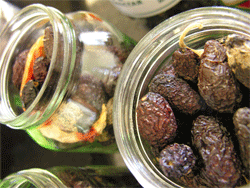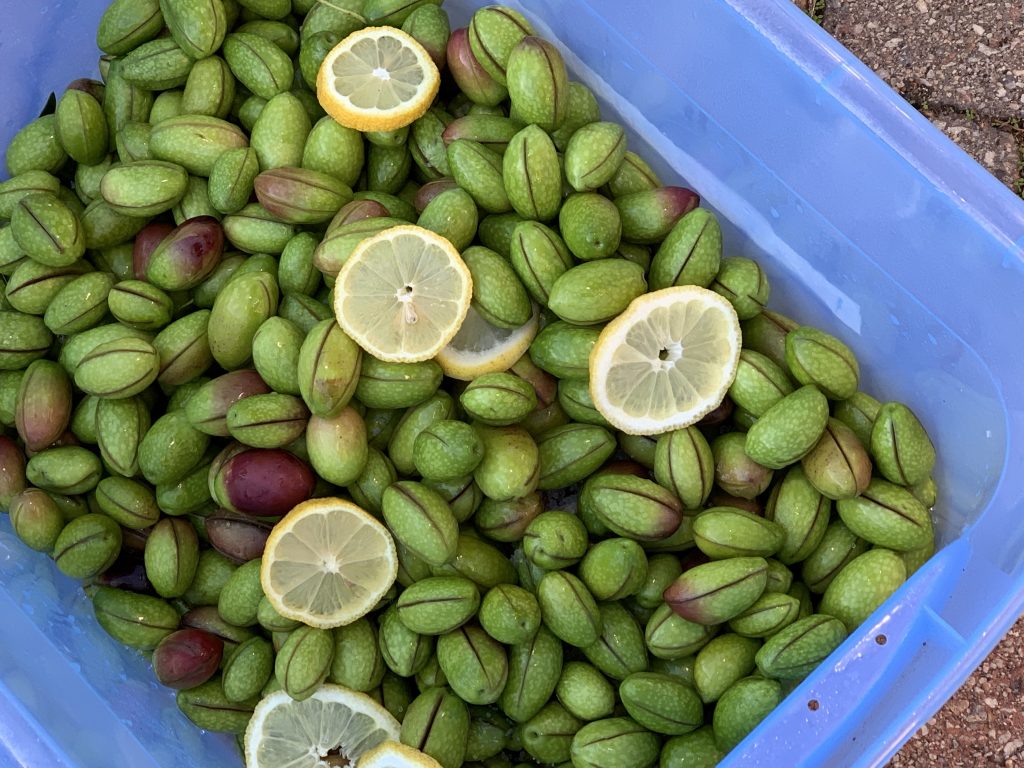EVERYTHING YOU NEED TO KNOW ABOUT CURING OLIVES



simple,
utterly fool proof
salt curing method for black olives
For more than a couple of kilos, sit a colander (we use big plastic colanders and bowls from our Chinese grocer) over a bowl, and spread a layer of rock salt in the bottom. Put a layer of olives, then salt, and continue repeating the process, finishing with a thick layer of salt. The beauty of this method is the bottom olives don’t sit in a saturated salt solution and cure much quicker than the top olives. Green olives can take anything up to three months to clear themselves of their bitterness, whereas black olives, especially the very small feral olives cure very quickly and when very ripe can take as little as a week.
Tasting from the top is the best test, and if they are no longer bitter they are ready to come from the salt. Remember when you wash off your salt that if you choose the garden choose a spot where the run off will not kill everything in its path.
Olives cured by this method can then be bottled in a brine solution of 20g of salt, 100ml Vine Valley white wine vinegar for every litre of water, or rather more extravagant, but especially good covered in a mixture of 100ml balsamic, 10g whole pepper, 3 cloves of garlic, 3–4 chillies split lengthwise, 3 fresh bay leaves and 1 litre of olive oil. Common sense is required when adding the salt at this stage if you think the olives are excessively salty rather than tasty with a strong salt flavour, put 5g per litre and check them in a week or two.
Quantity in both cases depends of the size of your jars and the amount you are preparing. The best way to figure out how much you will need is to fill your jars with olives, fill them with water and then tip that water into a bowl set and tared on a scale and measure the amount. Another 6–8 weeks and your olives will be ready for eating.
tips
- Pickling recipes can never be absolute, you have to taste them and making sure the salt can drain properly is vital if they sit in the salt solution, the bottom olives will be ready before the top olives.
- We don’t have a cellar and have found finding storage places in a kitchen where the temperature is not constant has become increasingly hard, especially with recent prolonged heatwaves where the ambient temperature has been well over 30°C for anything up to 10 days at a time. So, where you store your olives is important!
if you let your olives get too dry
- Depending on how dry they are cover them with hot (a little too dried out) and boiling (very dried out) and let them sit for about an hour until the water cools and the flesh is a little softened.
- Taste the olives if they are still very salty, repeat the process until the have a good taste again.
- Rinse them off and proceed to put them into oil.
Especially good for jumbo green olives
A turning [beaked knife] is best for this. Make three slits to the stone in each olive. Rinse off the olives under cold running water and then do the following.
for every 1.5kg slit olives
- 5L [5kg] water, 80g sea salt and 1 medium lemon sliced.
- Change the solution daily…and here lies the need for common sense. It is impossible to give the precise number of days this process will take. Everything depends on how ripe the olives were and what the ambient temperature. After five days start tasting the olives…all bitterness needs to be gone and you need to keep changing their bath on a daily basis until they are no longer bitter.
- When they are ready wash them under cold running water and put them into the following solution.
- Whilst putting olives down in many recipes sterilising your jars is scorned, we think it is good advice….for more information take a look at our preserving bible where you will find plenty of information about sterilising containers.
- Fill the jars with a solution of 20g of salt, 100g Vine Valley white wine vinegar for every litre [1kg] of water and cover with a 1cm layer of extra virgin olive oil…if you’re planning martinis skip the oil layer but keep your eye on them because there is much more chance of them going off….but the joy of a decent olive in a martini is rarely found in a bar.
- These olives are considered ‘naked’ and although most cooks would marinate them before serving
Bashed green olives
Crushed green olives are a lot more work but the end result draws wild acclaim. They ugly but divine!
Basically we are used the method from Pietro Demaio’s Preserving the Italian Way p84 variation
Make sure to keep your olives in the fridge if you are not going to pickle them immediately. Frank Camorra in his first book MOVIDA also confirmed the method as a favourite with his family for green olives.
Crush the olives with a meat mallet. Rinse them under cold running water, place them into 5L containers where the weight of the olives does not exceed 1.5kg. Add a sliced lemon to each container and 80g sea salt and cover liberally with cold water.
Change the brine every day and after about five days start tasting them. It is impossible to give you a set time it depends on how ripe the olives are and in some instances the variety. A couple of years ago one batch took five days, the second which were much harder a week.
Rinse them well and then put them into EV olive oil with lots of mint, a little bit of very hot green chilli and garlic……heavenly! If the garlic is shooting remove the germ because it isvery bitter.
Best of all they are generally ready for eating within a month.
Don’t stint on quality oil, the oil from the olives is just exquisite and can be used for marinating and cooking!
naked and dressed olives
Even olives stored in brine should be well drained and marinated in a little olive oil before serving them as an appetiser, and for your martini, straight from the brine, well drained, spiked with a toothpick and into the glass.
more tips
- The great thing about the salted dried olives is that they keep indefinitely and you don’t need to put them into oil or marinate them immediately. Do not wash the olives off until you want to put them into oil or a marinade, but you must brush off as much of the salt as possible.
- If you have a vac machine, vac them. They are easy to store and don’t take up so much room.
- If you leave the olives in the salt too long you can always put them right again and soak them in cold water until they are fine again.
- Once they have been washed of the olives must going into a marinade or olive oil.
